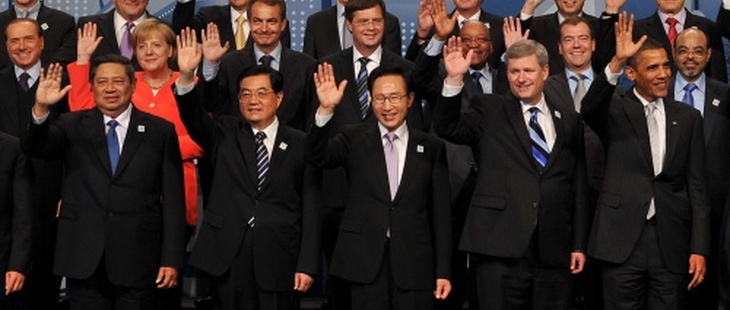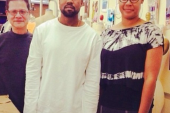
 Elise Troister
Elise Troister
Womenswear has become the fashion world’s de facto United Nations—superficially global with minimal social progress. No one really cares if it’s Navajo or Nanaimo (so long as America pays the bills), but on some level there’s a desire to seek new trends and experiment with foreign modes of sartorial expression.
Menswear, meanwhile, has evolved into something vaguely resembling MuchMusic: no amount of snarky hipster lexicon can cover up for its gross cultural irrelevance. It remains stagnantly Western, and more specifically, British. At one point this diversity dike could be blamed on men’s aversion to, well, fashion. But with men everywhere jumping on the “maybe I should wear a belt with this” bandwagon, that excuse flies out the glory hole in favour of a more sociological explanation.
It all started with the Brits. Streamlined suits, skinny ties, button-down shirts, trench coats, polo shirts, and countless other male wardrobe staples all have Redcoat roots. Back in May, Oliver Spencer quipped to The Guardian: “If you looked at a line-up of current menswear looks and asked someone to pick out the British outfit, you’d find every item has a British influence.” America can be credited for a few gems, like jeans, but when fair isle qualifies as a foreign influence and bowties count as quirky, you’ve got diversity problems.
Menswear companies advertise to the “international man,” but they aren’t targeting the guy who speaks three languages or knows what percentage of the annual U.S. budget goes to foreign aid (it’s 1%); they’re reaching out to the jet-set businessman who owns the boardroom, takes his stewardesses shaken, and has a strong conviction that China should not be allowed to develop nuclear weapons. They mean international in the way that James Bond is international but also a rich white guy.
Some might jump to blame the “mancession,” but that’s not it either. Designers continue to expand their menswear collections, just as upstart magazines for the scruffier gender give a second life to style journalism. In the midst of a global recession, 2010 saw Macy’s and Kenneth Cole launch a line for the “millennial” man, powerhouse Tory Burch publicly flirt with the idea of a menswear line, and Oliver Spencer open his first Canadian outpost in Toronto. In such a rapidly growing market, new looks should be (almost) as hot as Nelly circa 2002.
The rise in China and India’s consumer buying power makes the diversity shortage even more confusing. With brands scrambling to do business with these markets, you’d think more cultural spit-swapping would be inevitable.
And yet the core of men’s fashion has never been about trends or simply “looking good.” Clothes have the power to impose social identities and boundaries, hence “the clothes maketh the man.” In Men and Menswear: Sartorial Consumption in Britain 1880-1939, Lauren Ugolini describes the intrinsic function of men’s fashion: “As far as men were concerned, far from being an irrelevance or a meaningless activity, clothes consumption played an important part in constructing and reinforcing male identities.” Men have historically used their wardrobes as sartorial power tools; it’s all about dominance—physical, economic, and sociological.
This is why so many menswear staples have roots in the military, some more obvious than others. Even boutonnires, seemingly a more feminine accessory, originate from the tradition of loved ones pinning a flower on soldiers’ lapels as they head off to combat. The stripe or ribbon on tuxedos is an imitation of marine’s blue dress uniforms, which have a notable red stripe (amiably nicknamed the “blood strip”) down the sides of their trousers. Thomas Burberry invented waterproof gabardine, the classic fabric used to construct most trench coats, for WWI soldiers to wear over their uniforms. Not only were these coats remarkably lightweight and breathable, but also, they boasted shoulder straps for rank insignia and “D” rings for attaching hand grenades (or Kate Moss’ crack pipe).
Hugo Boss built its luxury empire on constructing suits that exude power—although many consumers aren’t aware of how that power was used. The suiting company known for its heir-on-heroin ads has a skeleton in its closet, and it’s not Orlando Bloom. Hugo Boss was a member of the Nazi Party and manufactured the SS division’s namesake uniforms. His sleek and streamlined black designs, now hailed as “slimming” for executives, were originally intended to strike fear and submission into the hearts of Germans. The Hitler Youth were also decked out in Boss suits, creating such intense demand that Hugo used 40 prisoners of war and 150 forced laborers to keep up the pace. (Ed note: And if you think this is old news, what of the revived Hitler Youth haircut, so noted by the New York Times?)
Even outside of military and genocidal pursuits, mens fashion is all about big balls. Apparently its icons must contribute either blood or sweat to the universe, so in peacetime, men turn to athletes like David Beckham. His haircuts, penchant for layering, and love of designer suits changed the way men dress. David’s ability to primp himself and still woo the ladies made caring about fashion acceptable, even desirable, for straight men. Dolce and Gabbana once credited Beckham as “the most influential man in fashion.” The recent NBA lockout saw athletes attempt to maintain their star power through fashionable side projects: Dwayne Wade posed for GQ (in a turtleneck no less), Baron Davis declared a war on sweats and began a documentary on the decline of style in the U.S., and Chris Bosh told The Cut that dressing well translates into on-court swagger.
History shows that while womenswear trends are predicated on empty status, menswear trends are the result of men imitating power; it makes sense that a gaping diversity hole in Western menswear could be due to the perceived weakness of other cultures. The reluctance of men’s fashion to globalize makes for an interesting sartorial commentary on power politics between nations, lasting imperialist attitudes, and even ethnic supremacy. Menswear is one of the greatest carriers of cultural hegemony—particularly to nations where men still hold most of the power.
When American businessmen meet their Chinese counterparts to negotiate a contract, they’re undoubtedly in Western wear: there’s a subconscious effect to that. Male international politicians dress like the President of the United States at summits and state visits, not the other way around. These fashion choices are an unconscious show of their willingness to fold to American demands and policies; they give the West a sartorial home court advantage. This is in stark contrast to first ladies who often wear foreign designers while abroad: Kate Middleton wore Erdem when she landed in Canada, and Michelle Obama made a point of showing off smaller British labels like Roksanda Illinic and Preen while in the UK. In fact, Michelle Obama once came under fire from Oscar de la Renta when she wore neither American nor Chinese, but Alexander McQueen, to a state dinner honouring the People’s Republic of China. The male political class simply isn’t held to the same standards of diplomatic dress (unless you count Bush and Putin taking five seconds to throw on muumuu-esque Vietnamese robes so outdated they’re only still used for the odd wedding dress and little girls’ school uniforms–a real effort at diversity).
Even domestically, potential employees are expected to dress in step with the mostly Anglo-Saxon ruling class. Style conformity is necessary to climb the proverbial corporate ladder, ensuring power remains invested in those who adhere to the status quo class structure.
For all the recent talk of expanding men’s closets and providing more dress options, it seems we might be stuck with the same old stylings until there’s either a significant shift in world power or a truer acceptance of multiculturalism. Change in men’s fashion needs to be initiated on a deeper sociological level—something that can’t be forced. And they call us complicated.














